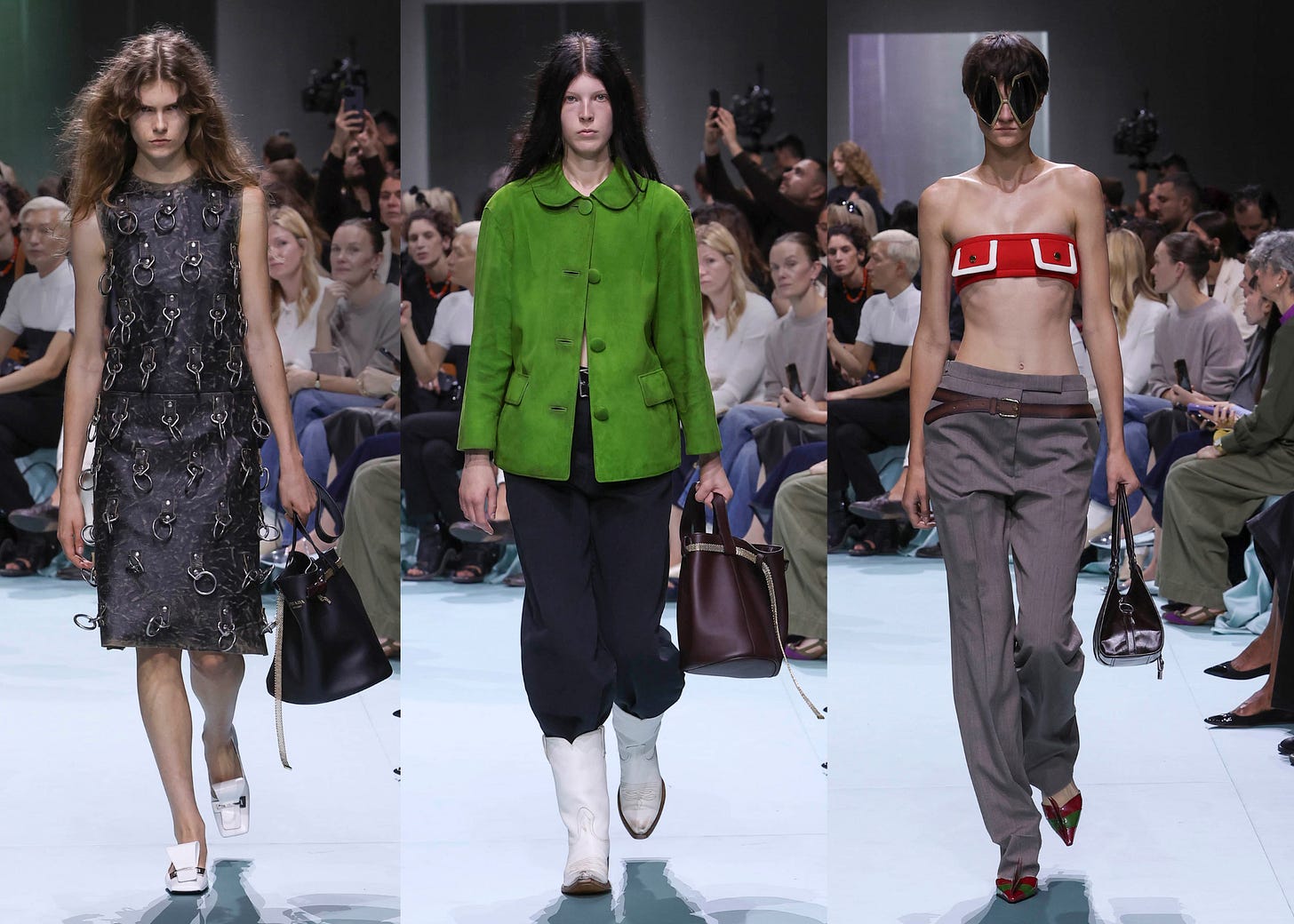Do Miuccia Prada and Raf Simons Read BuzzFeed?
The question of our time. Plus: Bottega, Dolce, and more from Milan!
In today’s issue:
Did Prada’s “algorithm”-inspired show really live up to all that hype?
Why fashion people still love Bottega so much (it probably wasn’t that they gave them bean-bag chairs instead of metal benches, but those were a nice touch).
More from Milan, including Madonna at Dolce, Gucci, and Marni.
Maybe Miuccia Prada thought of “the algorithm” as inspiration before she presented her spring 2025 show in Milan. Maybe she and her design partner Raf Simons created the looks, regarded them, and said, “I know, the algorithm!” as inspiration after they were basically done, which is how the Olsens often put together The Row collections.
It was not immediately obvious to me what these clothes had to do with “algorithms.” I’m not convinced it was clear to Simons and Prada either, given the nonsensical show notes:
We exist in an era of extreme information, immersed in a constant stream of content. Our consumption of the infinite panorama offered by the Internet is driven by algorithms, finite sequences of instructions that circumscribe the decidable through logic in a fundamentally illogical world. If that interpretation posits an architecture of understanding, in contrast humanity can be defined by its unpredictability, a rejection of the derivative and expected. Here, a discourse is opened, provoked, between these two distinct perspectives.
The first thing I noticed about this collection was the lofty praise it drew from every corner of the fashion media, including established critics, TikTokers, and fellow Substackers. Though I somehow doubt pleasing all of those groups was the intention of the collection, that seemed to be the real comment the show made on “the algorithm.” How quickly opinions align, or seem to. The Cut’s Cathy Horyn called it “exhilarating”; Booth Moore’s WWD review was headlined “A Bolt of Fashion Lightning”; creator Mandy Lee called it “what teenagers growing up in 2040 will reference and covet and worship much like Prada 1999”; and
of Shop Rat is particularly excited about the shoes.Looking at this reaction, my first thought was, “Wow, fashion people are really tired of minimalism!” As Nicole Phelps wrote for Vogue, “This was the most bonkers Prada show in some time, one with a superhero-from-outer-space streak, thanks to the goggle hats and porthole skirts, with additional touches of BDSM and cowboy Americana in the form of skirts suspended from harnesses and another trimmed with long white leather fringe.” There were also ribbed tights with belt loops worn as pants; a leather dress covered in dangling metal rings; and oversized alien-looking sunglasses.
I often find it challenging to write about these shows because we’re looking at clothes that almost no one buys and that might not even ever get made for people to buy. Many runway shows are understood to be in service of accessories sales. And Prada is one such accessories brand — influencers wear the clothes to events while it seems like a safe bet that most customers tend to just buy the bags and/or the shoes. And by that measure, this show was a win, in terms of making people want to buy.
The show included 49 models, each of whom wore a different style of shoe. Not all of them carried bags, but the ones that did seemed to carry all different styles. Some shoes were reissues of past styles — platform oxfords from spring 2011, heels from fall 2008, platform Mary Janes from fall 2012, a heeled loafer from spring 2020. This seems wise in an era where people are scouring The Real Real for designer items, which have ballooned in price. (The cheapest dress for sale on Prada.com in the U.S. right now is a cotton polo mini for $1,120, while anything with embroidery starts at $6,100, and the most expensive is $16,600; the cheapest shoe is a white rubber flip-flop for $695.) Even mall brands like Victoria’s Secret make “archive” collections that are new versions of old items people might be able to buy on the vintage market.
It seems fine for these brands to suggest that people don’t need newness all the time. But it’s also impossible not to view these accessories as derivative, and not just because they’re quite literally derivative of past collections.
Keep reading with a 7-day free trial
Subscribe to Back Row to keep reading this post and get 7 days of free access to the full post archives.




